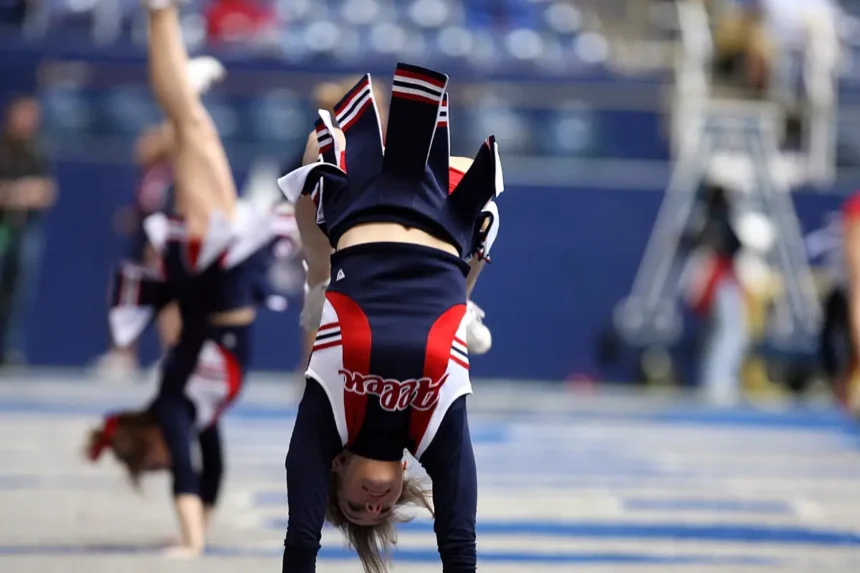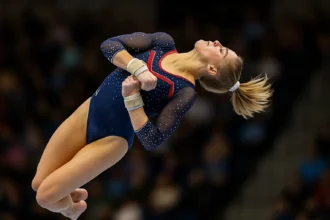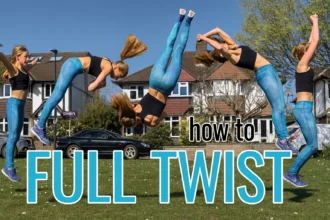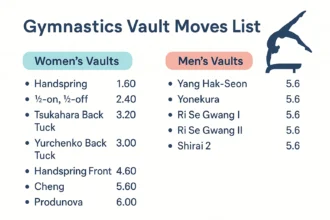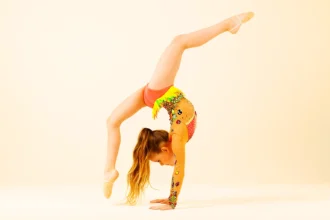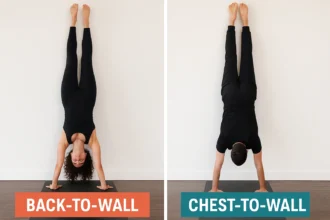Tumbling is a crucial skill for both gymnastics and cheerleading. While the foundation of acrobatic movement is shared between the two, the techniques and approaches are quite different. Let’s break down the key differences between gymnastics tumbling and cheer tumbling to see how each discipline trains and executes their skills.
1. Perfection vs. Just Get It Done
One of the main differences between gymnastics and cheerleading tumbling is the mindset. Gymnastics is all about perfection. Every move is practiced until it’s as close to flawless as possible. Gymnasts focus on hitting the right shapes and angles, and if even a small part of their technique is off, it can feel like failure. It’s about getting every detail perfect, every time.
This focus on perfection can sometimes lead to mental blocks, where gymnasts get stuck because they’re so focused on being perfect. However, the upside is that gymnasts usually have solid technique and control.
On the flip side, cheerleaders have more of a “throw it” mentality. While progression is important, cheerleaders are often encouraged to just perform their skills as best as they can, even if they’re not perfect. For example, it’s common for cheerleaders to go from learning a roundoff to throwing a standing tuck in just a few months, sometimes under pressure to perform for a competition.
This approach pushes cheerleaders to try new things quickly, but it can also mean they don’t always focus on perfecting each skill, which can increase the risk of injury. Gymnasts, in contrast, tend to avoid these risks by emphasizing controlled movements and body awareness.
2. Training Focus: Depth vs. Variety
In gymnastics, tumbling training is very focused on mastering individual skills. Gymnasts work on both front and back tumbling, and they spend a lot of time developing strength, flexibility, and body control to perform complex skills like double flips or triple twists. It’s all about refining technique over time, often for years.
Cheerleaders, however, focus more on running and standing tumbling. Running tumbling involves skills like back handsprings and tucks, often strung together in a series. Cheerleaders do some front tumbling, like front tucks or walkovers, but it’s usually just to set up other moves. Their training is more about creating fluid combinations of skills rather than perfecting each one individually.
Gymnasts tend to have fewer combinations, but they focus on executing each skill with high precision and control. This means gymnasts train for more complex skills, but the physical preparation required is different from the style of cheerleading tumbling.
3. The Type of Passes: Power vs. Combination
When it comes to tumbling passes, gymnasts typically perform high-power skills. Their passes involve explosive moves, like back handsprings into double back tucks or arabians. These skills require strength, speed, and control, and gymnasts put in hours of training to master them.
Cheerleaders, however, focus on combination passes, where they blend different skills together in one continuous flow. For example, a cheerleader might do a front walkover, followed by a cartwheel, a back handspring, and then a tuck. The goal here is to link skills seamlessly rather than focusing on the raw power of any one move. This approach allows cheerleaders to work with a wider variety of skills and create a visually impressive routine.
Even though cheerleaders don’t always perform the same high-level individual skills as gymnasts, their tumbling still requires strong technique. Their routines are designed with teamwork in mind, so the flow and timing of their passes are just as important as the individual strength and control required in gymnastics tumbling.
4. Standing Tumbling vs. Running Tumbling
There’s a noticeable difference when it comes to standing tumbling. Gymnasts generally train running tumbling, where they build speed and power before executing their moves. This momentum helps them perform high-flying, powerful tricks. While this method can be impressive, it also means gymnasts are more likely to over-rotate or lose control of their movements, especially if they add too much power to their skills.
In cheerleading, standing tumbling is a key part of their training. This skill doesn’t rely on momentum from a running start, so it demands excellent control and technique. Cheerleaders perform standing skills like back handsprings, tucks, and fulls, which helps them build the control they need to perform skills precisely, especially in the middle of a fast-paced routine. Standing tumbling gives cheerleaders more control and makes it easier for them to land skills safely and confidently.
While both types of tumbling have their challenges, standing tumbling provides cheerleaders with the control they need to perform well, while running tumbling in gymnastics can sometimes lead to over-execution of skills if too much power is added.
5. Routine Context: Individual vs. Team Focus
Another major difference is the focus of the routine. In gymnastics, the tumbling routine is all about the individual tumbler. Gymnasts have the time to focus on their technique, their timing, and their performance. They spend months preparing for their floor routine, and the calmness that comes with preparation helps them execute their skills confidently. In gymnastics competitions, it’s all about performing that routine perfectly.
In cheerleading, tumbling is just one part of a larger routine. Cheerleaders need to focus on stunts, jumps, and choreography, all while working as part of a team. Because of this, the emphasis is often on making the routine come together, rather than perfecting each individual skill. Cheerleaders have to be aware of their teammates and the timing of the routine, which can sometimes lead to unpredictable moments—like accidentally bumping into someone or needing to adjust on the fly if a stunt goes wrong.
This team aspect makes cheerleading routines more dynamic and energetic, while gymnastics routines are more focused on precise execution and individual performance.
Wrapping It Up
At the end of the day, both gymnastics and cheerleading tumbling require incredible skill, strength, and control, but the way each sport approaches it is different. Gymnasts focus on perfecting individual skills with precision, while cheerleaders work to create smooth, high-energy combinations within a team environment. Both approaches have their advantages, and there’s plenty both sports can learn from each other.


